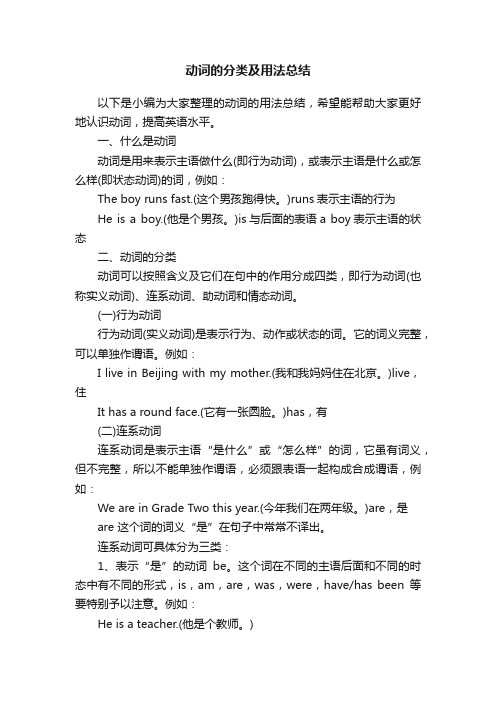动词分类及几类常见的特殊行为动词
初中英语动词分类大全

初中英语动词分类大全(附练习)一、什么是动词动词是用来表示主语做什么(即行为动词),或表示主语是什么或怎么样(即状态动词)的词,例如:The boy runs fast.(这个男孩跑得快。
)runs表示主语的行为He is a boy.(他是个男孩。
)is与后面的表语a boy表示主语的状态二、动词的分类动词可以按照含义及它们在句中的作用分成四类,即行为动词(也称实义动词)、连系动词、助动词和情态动词。
(一)行为动词行为动词(实义动词)是表示行为、动作或状态的词。
它的词义完整,可以单独作谓语。
例如:I live in Beijing with my mother.(我和我妈妈住在北京。
)live,住It has a round face.(它有一张圆脸。
)has,有(二)连系动词连系动词是表示主语“是什么”或“怎么样”的词,它虽有词义,但不完整,所以不能单独作谓语,必须跟表语一起构成合成谓语,例如:We are in Grade Two this year.(今年我们在两年级。
)are,是are 这个词的词义“是”在句子中常常不译出。
连系动词可具体分为三类:1、表示“是”的动词be。
这个词在不同的主语后面和不同的时态中有不同的形式,is,am,are,was,were,have/has been等要特别予以注意。
例如:He is a teacher.(他是个教师。
)He was a soldier two years ago.(两年前他是个士兵。
)We are Chinese.(我们是中国人。
)2、表示“感觉”的词,如look(看起来),feel(觉得,摸起来),smell(闻起来),sound(听起来),taste(尝起来)等,例如:She looked tired.(她看一去很疲劳。
)I feel ill.(我觉得不舒服。
)Cotton feels soft.(棉花摸起来很软。
)The story sounds interesting.(这个故事听起来很有趣。
动词的分类

③must+have done常用于肯定句,表示过去发 生的行为的肯定推测。其否定式用can’t have done。 如:It must have rained yesterday evening,for the ground is wet. 昨晚一定下过雨了,因为地面湿了。 John can’t have gone to England.I just saw him on the street. 约翰不可能去英国,我刚在路上看见他了。
(6)should表示“劝告”、“建议”、“惊奇” 等意思。 如:We should work hard. 我们应该努力工作。 (7)will 表示“意愿”、“决心”等意思,一 般与第二人称连用。 如:Will you teach me how to dance? 你能教我如何跳舞吗?
(8)would表示过去的意愿决心等,would 还可以表示过去经常发生的事情;还可以表 示现在的情况,表达说话人向对方提出的要 求,语气比will 婉转、客气。在日常会话中, “我想要……”通常用“I would like to…”或 “I should(I’d) like to…”来表示。 如:My grandma would tell a story before sleeping.睡觉之前,外祖母总是给我讲故事。 Would you like a cup of tea?来杯茶怎么样?
如:How dare you tell her my secret? 你竟敢告诉她我的秘密? He doesn’t dare to quarrel(争吵) with me. 他不敢和我吵。 (11)had better do (最好是)一般也当作情态 动词使用,否定式是had better not (do)。 如You’d better drink more water.你最好多喝水。 You’d better not sleep too late. 最好不要睡得太晚。
高中英语动词用法详解-文档

高中英语动词用法详解-文档动词及动词短语用法详解动词是描述主语的动作行为或状态的词。
几乎每个句子的表述都离不开动词。
动词是英语句子的重心,是英语句子中不可缺少的一部分。
动词通常在句子中作谓语,它种类繁多,形式复杂,是较复杂的语法项目之一。
I动词的分类根据动词的句法功能可将动词分为实义动词、连系动词、持续动词和非持续动词、助动词和非谓语动词。
1.实义动词实义动词包括不及物动词和及物动词两类。
1)不及物动词:不及物动词指不能跟宾语的动词。
在英语中大多数动词既可以作及物动词,又可作不及物动词。
纯粹的不及物动词很少。
常用作不及物动词的主要有ache疼痛,agree同意,apologize道歉,appear出现,arrive到达,come来,XXX哭,XXX跳舞等。
XXX.我们一直等到妈妈来。
2)及物动词:能跟宾语的动词称为及物动词。
英语中的动词大多数为及物动词。
(1)跟单宾语的及物动词只跟一个宾语的动词称为单宾语动词。
常见的单宾语动词主要有:accept接受,admire羡慕,admit承认,affect影响,afford买得起,announce公布,borrow借出,XXX埋等。
I'm sorry that I XXX.对不起我忘了你的电话号码。
(2)跟双宾语的及物动词可以同时跟两个宾语的及物动词叫双宾语动词。
双宾语中的一个宾语指人,称为间接宾语,一个宾语指物,称为间接宾语。
间接宾语普通位于直接宾语之前,也可位于其后,但此时在间接宾语的前面需加介词to或for。
直、间接宾语易位需加to的动词介词to侧重指动作的方向,表示朝着、向着、对着某人。
常见的此类动词有:tell通知,XXX借等。
Hand me that book, please.= Hand that book to me, please.请把那本书递给我。
直、间接宾语易位需加for的动词介词for侧重指动作的受益者,透露表现为或人、替或人。
动词的种类

1. These oranges taste ____.
A. good C. to be good B. well D. to be well
2. ---Do you like the material? ---Yes, it ____ very soft.
A. is feeling
C. feels
直接接宾语
• They listened carefully!
不接宾语
• They always listen to music.
介 词
加介词后 接宾语
及物动词与不及物动词
及物动词本身意义不完整,需要接宾语才能使其 意思完整。
• • 动词 + 宾语 I like this book very much. 动词 + 宾语 + 宾补(即加复合宾语) Rainy days make me sad. • 动词 + 间接宾语(sb)+ 直接宾语(sth)
如: • We speak Chinese. • The baby can speak. • Boys fly kites. • Birds can fly.
(2) 有些不及物动词与一些别的词搭配在一起构成 动词短语,其作用相当于及物动词,要注意积累。
① 动词+介词 Look at the blackboard. ②动词+副词 He turned off the light when he left. He picked it up and gave it to me.
D. refuse
2. Jane _____ the book for two months.
A. has kept B. borrowed
动词的分类及用法总结

动词的分类及用法总结以下是小编为大家整理的动词的用法总结,希望能帮助大家更好地认识动词,提高英语水平。
一、什么是动词动词是用来表示主语做什么(即行为动词),或表示主语是什么或怎么样(即状态动词)的词,例如:The boy runs fast.(这个男孩跑得快。
)runs表示主语的行为He is a boy.(他是个男孩。
)is与后面的表语a boy表示主语的状态二、动词的分类动词可以按照含义及它们在句中的作用分成四类,即行为动词(也称实义动词)、连系动词、助动词和情态动词。
(一)行为动词行为动词(实义动词)是表示行为、动作或状态的词。
它的词义完整,可以单独作谓语。
例如:I live in Beijing with my mother.(我和我妈妈住在北京。
)live,住It has a round face.(它有一张圆脸。
)has,有(二)连系动词连系动词是表示主语“是什么”或“怎么样”的词,它虽有词义,但不完整,所以不能单独作谓语,必须跟表语一起构成合成谓语,例如:We are in Grade Two this year.(今年我们在两年级。
)are,是are 这个词的词义“是”在句子中常常不译出。
连系动词可具体分为三类:1、表示“是”的动词be。
这个词在不同的主语后面和不同的时态中有不同的形式,is,am,are,was,were,have/has been等要特别予以注意。
例如:He is a teacher.(他是个教师。
)He was a soldier two years ago.(两年前他是个士兵。
)We are Chinese.(我们是中国人。
)2、表示“感觉”的词,如look(看起来),feel(觉得,摸起来),smell(闻起来),sound(听起来),taste(尝起来)等,例如:She looked tired.(她看一去很疲劳。
)I feel ill.(我觉得不舒服。
英语动词的分类和用法

或瞬时间完成结束。 discover; fall; leave; open; put
on; take off; sell; start; stop;
return; go; jump……
C 表示状态改变或位 置转移的动词.
arrive,change,come,die,go,land (着陆),leave…
operate +on
return +to
think +of/ about/ over
rely + on
stick +to sth compete + in sth with
insist + on doing graduate +
sb
from
agree + to/ with / on
suffer +from work +on/ at/ in/for
同时是情态动 词
5 will
形式变化:would
同时是情态动 词
状态系
1
be
动词
表像系
2 动词
look / appear/ seem
特别说明: 这里列举的所
感官系
有系动词本身
系3 动词
feel / smell/ sound/ taste
都是实义动词。
动
持 续 系 keep/ rest/ remain/ continue/ last/ 但 它 们 表 示 的
动 B 动名 词词
C 现在 分词
D 过去 分词
doi 形式变化:not doing
今后
ng
有专
形式变化:having done/ having been
日语各动词知识点总结
日语各动词知识点总结一、动词的分类1. 动词的分类日语动词分为五种类型,分别是一类动词、五段动词、来自动词、サ变动词和カ变动词。
这五种动词的活用形式各不相同,需要分别进行学习和掌握。
2. 一类动词一类动词是日语中最基本的动词类型,也是最常见的动词类型。
这类动词的活用形式相对规律,基本上只需要记住词干和词尾的规律即可。
一类动词的词尾变化包括连体形、未然形、已然形、命令形和条件形等。
3. 五段动词五段动词是另一种常见的动词类型,也可以说是日语中最常用的动词类型之一。
五段动词的词尾变化相对复杂,需要掌握详细的规则和变化形式。
五段动词的活用形式包括连体形、已然形、命令形、未然形和假定形等。
4. 来自动词来自动词是指那些以“e”或“i”结尾的动词,这类动词的词尾变化规律与一类动词有一定的相似之处,但也有一些特殊的变化规则需要额外掌握。
5. サ变动词サ变动词是另一种常见的动词类型,这类动词的活用形式也相对复杂。
サ变动词的词尾变化规则与一类动词和五段动词有一些共通之处,但也有一些特殊的规则需要记住。
6. カ变动词カ变动词是最特殊的动词类型,这类动词的活用形式非常独特,需要额外的记忆和掌握。
カ变动词的词尾变化规则与其他四类动词有较大的不同之处,是日语动词中的特殊存在。
二、动词的用法1. 动词的肯定形日语动词的肯定形通常是指未变形态的动词形式,用于表示主语的行为或状态是肯定的。
动词的肯定形可以用于陈述句、疑问句、感叹句等不同的句子结构中。
2. 动词的否定形日语动词的否定形通常是在动词词尾加上“ない”来表示否定。
动词的否定形用于表示主语的行为或状态是否定的。
动词的否定形在句子结构中也可以用于陈述句、疑问句、感叹句等不同的句子结构中。
3. 动词的过去形日语动词的过去形通常是指表示过去的动作或状态的动词形式。
动词的过去形使用不同的规则进行变化,需要掌握不同类别动词的过去形规则和变化形式。
4. 动词的进行形日语动词的进行形通常是指表示正在进行中的动作或状态的动词形式。
英语动词的分类及基本形式
英语动词的分类及基本形式英语动词的分类及基本形式英语动词的分类及基本形式:表⽰动作中状态的词叫做动词。
根据其在句中的功能,动词可分为⾏为动词(即Action verbs实义动词,分为及物动词和不及物动词)、系动词(The Linking Verb)、助动词(The Auxiliary Verb)和情态动词(Modal verb)四类,有些动词是兼类词。
如:We have lunch at 12. 我们12点吃午饭。
(have是⾏为动词)We have been to New York. 我们去过纽约(have是助动词)I am hungry. 我饿了。
(am是连系动词)She was beaten on the way home. 她在回家的路上被⼈打了。
(was是助动词)You needn’t have waited for me. 你本来不必等我。
(need是情态动词)The door needs painting. 这个门需要油漆了。
(needs及物动词)■动词的基本形式绝⼤多数动词都有五种基本形式:动词原形、⼀般现在时(第三⼈称单数)、现在分词、过去式和过去分词。
A.⾏为动词即实意动词,表⽰动作的动词。
它分为及物动词和不及物动词两种及物动词后⾯必须跟宾语意义才完整的实义动词,叫做及物动词(transitive verb)。
如:I believe that the committee will consider our suggestion.我相信委员会将会考虑我们的建议。
“How long can I keep the book ?”Harry asked.哈⾥问:“这本书我可以借多久?”Dr. Bethune set us a good example. ⽩求恩⼤夫给我们树⽴了好榜样。
Crude oil contains many useful substances.原油含有许多有⽤的物质。
英语动词的分类
动词分类:动词有助动词、情态动词、联系动词和行为动词四类。
一)助动词助动词没有任何含义,不能单独做谓语,只能和行为动词一起构成谓语,帮助行为动词组成各种时态、语态、语气以及疑问或否定形式。
常见的助动词有be, do, does, did, have, will, shall等。
具体用法如下:1、助动词be的用法如下:1)构成各种进行时态。
如:It was raining all day yesterday.昨天整天下雨。
2)构成被动语态。
如:The meeting was held yesterday afternoon.会议是昨天下午举行的。
3)与不定式连用表示按照计划、预先安排或规定要发生的动作。
如:They are to see an English film this evening.他们今天晚上看英语电影。
2、助动词do的用法如下:1)构成疑问式或否定式。
如:Does he think so?I didn't say anything about the result.2)在动词前加上do, does, did表示强调,意为"的确,确实"。
如:They do study hard.She does love him.He did want to help the old man.3、have: 助动词have 的过去式是had。
have和had均可与动词过去分词一起构成完成时态。
如:He has lived here for three years.As soon as the sun had set they returned.4、shall, should: 助动词shall只用于第一人称的将来时态;助动词should 是shall的过去式,构成过去将来时。
如:I shall send ten letters to my good friend.She wanted to know if I should go to the palace.二)情态动词情态动词有can (could), may (might), must, have to, shall (should, will (would), dare (dared), need (needed), ought to等。
英语动词用法详解
动词及动词短语用法详解动词是描述主语的动作行为或状态的词。
几乎每个句子的表述都离不开动词。
动词是英语句子的重心,是英语句子中不可缺少的一部分。
动词通常在句子中作谓语,它种类繁多,形式复杂,是较复杂的语法项目之一。
I 动词的分类根据动词的句法功能可将动词分为实义动词、连系动词、持续动词和非持续动词、助动词和非谓语动词。
1. 实义动词实义动词包括不及物动词和及物动词两类。
1)不及物动词:不及物动词指不能跟宾语的动词。
在英语中大多数动词既可以作及物动词,又可作不及物动词。
纯粹的不及物动词很少。
常用作不及物动词的主要有ache疼痛,agree同意,apologize道歉,appear出现,arrive 至U达,come来,cry哭,dance跳舞等。
We waited untilmom came. 我们一直等至妈妈来。
2)及物动词:能跟宾语的动词称为及物动词。
英语中的动词大多数为及物动词。
(1)跟单宾语的及物动词只跟一个宾语的动词称为单宾语动词。
常见的单宾语动词主要有:accept 接受,admire 羡慕,admit 承认,affect 影响,afford买得起,announce宣布,borrow 借出,bury 埋等。
rm sorry that I forgot your telepho ne nu mber.对不起我忘了你的电话号码。
(2)跟双宾语的及物动词可以同时跟两个宾语的及物动词叫双宾语动词。
双宾语中的一个宾语指人,称为间接宾语,一个宾语指物,称为直接宾语。
间接宾语一般位于直接宾语之前,也可位于其后,但此时在间接宾语的前面需加介词to或for。
直、间接宾语易位需加to的动词介词to侧重指动作的方向,表示朝着、向着、对着某人。
常见的此类动词有:post 寄,promise 答应,read 读,return 返还,show 给看,teach教,tell告诉,lend借等。
Hand me that book, please.二 Hand that book tome, please.请把那本书递给我。
- 1、下载文档前请自行甄别文档内容的完整性,平台不提供额外的编辑、内容补充、找答案等附加服务。
- 2、"仅部分预览"的文档,不可在线预览部分如存在完整性等问题,可反馈申请退款(可完整预览的文档不适用该条件!)。
- 3、如文档侵犯您的权益,请联系客服反馈,我们会尽快为您处理(人工客服工作时间:9:00-18:30)。
6 had better 提建议,翻译成 最好。。。 You ’d better give up smoking. You’d better not smoke. 7 need Need 用作情态动词时, 意思为: 需要,只用在否 定和疑问句中,不用在肯定句中, 其后+ 动词 原形 否定形式为 needn’t You needn’t get up so early, for we still have a lot of time left. Need 用作行为动词时,后+ to do 否定形式为 don’t need / doesn’t need I need to have a rest. You don’t need to do that.
行为动词的否定和疑问方法
否定:在行为动词前 don’t/doesn’t didn’t 动 词还原。 He likes dogs. He doesnpt like dogs. 疑问: 在句首前+ do/does/did, 动词还原 He likes dogs. Does he like dogs.
情态动词
情态动词的疑问和否定方法
疑问: 前提情态动词 He can swim. 疑问句___________ 否定句:在情态动词后+ not You must waste your time. 否定句___________
主要情态动词一览表
原形 can 过去式 could 词义
可以/可能/能够 可以/能够
助动词的否定和疑问方法
否定: 在助动词后+ not I will support you forever. 否定句为 I will not support you forever. 疑问: 前提助动词 He has seen that movie. 一般疑问句为 Has he seen that mobie?
系动词否定和疑问方法
1.be 的否定 在be 后面+ not, be 的疑问前提 be She is beautiful. She is not beautiful. Is she beautiful? 2. 其余的系动词的否定和疑问词方法与行为 动词的否定和疑问方法相同。 She looks beautiful. She doesn’t look beautiful. Does she look beautiful?
1 及物动词 后面直接+ 宾语 We love peace. 2 不及物动词 后面+ 介词+ 宾语 Don’t laugh at those who are in trouble. He is listening to music.
行为动词的后续搭配
及物动词+ 宾语 不及物动词+ 介词+ 宾语 宾语可以是名词,代词,动名词,不定式等 千 万不要用形容词,副词,动词原形做宾语。 I like happy. I like eat apples.
动词分类概述
英语中的动词是最活跃的词性,英语的时态 的体现,句子类型的体现都要落实在动词 的变形上,因此学好动词无疑是学好英语 的必经之路,掌握好各类动词也就成了英 语入门的瓶颈。
动词总体分类示意图
动词类别 特点 举例
助动词
构成时态, Have/has + done 语态,否定,Will+ do 疑问 Is + done do 情态动词 说话人的语 Must/may/can等 气 系动词 连接主语和 be/ look/sound/get 表语 行为动词 表示人的行 like/run 为
必须/一定 愿意
同义词组 be able to do
may
must will
might
must wll
had better need
should
无 无
应该
最好 需要
be supposed to do 无
无
各个情态动词的具体用法
1 can/could a. 表能力 Can you play the guitar? Yes, I can. No, I can’t. b. 表推测,多用在否定句中,翻译成 一定不 That man can’t be John, for he has gone to America. c. 表请求许可 Can/could I leave now? Yes, you can. / No, you can’t. 注意: 用could 提问用can 回答。 d. 表邀请 can you come to my birthday party? Yes, I’d love to, but …
2 may/might 用法 a. 表推测 意思为: 可能。。。 He may/might be ill, but I am not sure. b.表请求,许可 May I know your QQ number? Yes, you may. No, you mustn’t. c. 表祝愿 May you succeed.
d. 感官系动词 feel/smell/sound/taste/look He looks much younger than his real age. That sounds great. The cake tastes good. This kind of silk feels soft. e. 表变化系动词 become/get/go/turn/fall He fell asleep while listening to music. He got angy when he heard the news. His face went red when he realized his mistake.
Be 动词 ( am/is/are)
1 肯定句: 主语 + be 动词 + 其它( 名词/形容词/ 介词短 语/ 不定式等) He is a teacher. He is clever. He is at home. My dream is to become a teacher. 2 否定句: 在 be 动词后 + not 3 一般疑问句及其肯定或否定回答。 前提 be 动词, 肯定回答: yes, 主语+ is/are. 否定回答: no, 主语+ isn’t/ no,主语+ aren’t
Is your father at home? Yes, he is. No, he is not. 4 特殊疑问词 特殊疑问词+ 一般疑问句 Where is your father? Where are you from?
系动词的特征
不能独立做谓语,必须与后面的表语一起才 能构成谓语,有人称和数的变化。 He looks young. They look young.
4 will/would a. 表意愿 ---- will you marry him? ---- yes, I will. --- will you go fishing with me? --- yes, I will. b. 表示委婉请求 --- would you open the door please? --- would you mind opening the door? c.表决心 I will study hard from now on. ---Don’t waste your time anymore. --- I won’t.
系动词的分类
a. 表状态的 be She is beautiful. b. 表持续的系动词 He remains silent. 他保 持沉默 He stays angry with his mother for many years. keep healthy c. 表象系动词 seem/ appear She seems worried. He appeared tired.
行为动词
行为动词的定义及特征
表示主语的行为动作及状态,在句子中能够 独立作谓语,随着人称,数量,时态的变 化而变化。 He works in a hospital. They work in a hospital. He worked in a hospital last year.
行为动词的分类
常见的助动词
1 Be He is reading books now. The machine was invented last year. 2 has/have + done 3 do/does/did 4 will/would/shall
助动词的后续搭配
主语+ 助动词+ 主动词 + 其它 I will go to Beijing tomorrow.
情态动词的特征
1 情态动词不能独立做谓语,必须要和后面的主动 词一起才能构成谓语。 判断下列句子的正误 you must at home. You must be at home. 2 情态动词没有人称和数的变化,其后一律跟动词 原形。判断下列句子的正误. He can swimming. He can swims. He can swim.
3 must 用法 a.表命令 You must leave right away.你必须马上离开。 b. 表禁止 You mustn’t take photos here.你绝对不能在这拍照。 c. 表示推测 翻译成 一定 He must be in his office, for the light in his room is still on. 注意: mustn’t 不能表示否定的推测, 只能表示禁止, 要表示否定的推测 只能用 can’t Must 提出的疑问句,肯定回答用must.否定回答用 needn’t 或者 don’t have to. ---- must I hand in my homework today? ---- No, you needn’t/ you don’t have to.
